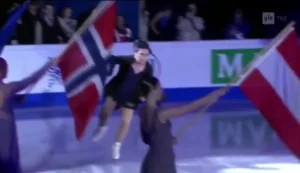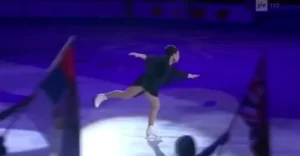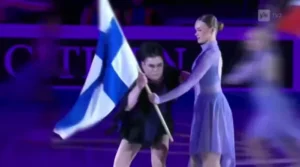World’s First Transgender Figure Skating Routine Goes Viral After Not Going According To Plan
In a captivating turn of events at the European Figure Skating Championships in Finland, the world witnessed the debut of Minna-Maaria Antikainen, the first transgender figure skater, marked by a remarkable fall during the opening ceremony.

Formerly known as Markku-Pekka Antikainen, the 57-year-old, a Siilinjarvi farm owner, embraced figure skating at the age of 49, making headlines at this year’s championship. Antikainen received a solo act from the Finnish Figure Skating Association during the opening ceremony, part of a broader initiative to champion diversity, equality, and inclusion in the sport.
However, nerves got the better of Antikainen. The figure skater, reportedly identifying as a gender-neutral woman according to Finnish news outlets, displayed a novice stumble, hitting the ice moments after starting the performance. Fortunately, a quick-thinking female hostess, proudly carrying the Finnish flag, rushed to assist, aiding Antikainen in a swift recovery.

Amidst the spectacle, some might sympathize with Antikainen, who, as reported by ‘pro-woman, pro-child safeguarding platform’ Reduxx Magazine, once expressed a childhood dream of becoming an ‘ice princess.’
Antikainen’s dedication to the sport is evident, with five hours of weekly on-ice practice leading up to the championships. Skating Finland reported Antikainen’s participation in several competitions both domestically and internationally prior to the ill-fated performance.
The theme ‘Just be you’ set the tone for the opening ceremony of the ISU European Figure Skating Championships. The Finnish Figure Skating Association aimed to underscore the significance of equality and diversity in the sport, sparking discussions about the potential continuation of the ban on ‘same-sex skating pairs.’
Outi Wuorenheimo, Executive Director of the Finnish Figure Skating Association, shed light on the conservative nature of figure skating, highlighting the various strict rules governing the sport. In international competitions, Wuorenheimo noted, same-sex skating pairs are not permitted, and there exists no specific category for non-binary skaters. Wuorenheimo expressed hope for a global push towards fostering equality and diversity within the field.

As debates unfold around this incident, Antikainen’s stumble becomes a focal point for broader conversations about inclusivity within the traditionally structured world of figure skating. It prompts reflection on evolving practices and fostering a more diverse and welcoming environment for participants across all backgrounds on the ice. While the fall may have been a momentary setback, the incident sparks a larger dialogue about the future landscape of figure skating and its commitment to embracing a more inclusive and diverse community.






